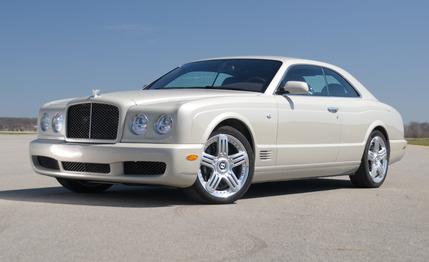 Road Test
Road Test
This road test may be irrelevant. Which wouldn’t necessarily make it unique to the pages of C/D. This time, however, it isn’t our fault. See, Bentley is going to create only 550 Brooklands—delivering the final one toward the end of 2009—and 549 of them are already spoken for. The grand-touring coupe you see on these pages, in a color Bentley calls “Porcelain,” is the last copy for sale. Or was at the time this was written.
But don’t sweat it. You probably couldn’t afford one anyway. The base Brooklands, including its $4500 guzzler tax, will set you back $348,085, “but practically no one is going out the door spending less than 400 grand,” notes Bentley’s PR guy. That’s because you’ll want add-ons like a $3190 retractable Flying B hood ornament, and you’d be crazy not to mix and match your Mulliner cockpit veneers—burr oak, burr walnut, bird’s-eye maple, olive ash, vavona, madrona, possibly even plywood—and any 5980-pound flagship wouldn’t be caught dead without the optional carbon-ceramic brake rotors, which will lighten your wallet by $29,270. (Right now, the reader may wish to reflect on vehicular purchases available to him for the cost of this car’s brakes alone.)
Your average Brooklands buyer owns eight automobiles and is worth $30 million. As such, he doesn’t buy the car himself. He sends a minion to buy it for him. So when the salesman says, “Jeez, I’ll have to go ask my manager,” the buyer probably replies, “That won’t be necessary.”
Alas, where to drive a car that so boldly proclaims, “ I am super-goddamn rich”? Simple: to the Grand Rapids Art Museum, featuring 100 examples of Andy Warhol’s art. Warhol was joyfully unrepentant about extending the fame of moneyed celebrities while simultaneously worshipping at the cathedral that is Chase Manhattan Bank. “It’s great to buy friends,” he said. “I don’t think there’s anything wrong with having a lot of money and attracting people with it. Look who you’re attracting: everybody!”
As we cruised at 80 mph toward the museum, the big car’s trunk mysteriously popped open on its own, disgorging a London Fog coat upon the wet surface of Interstate 96. Did we care? We did not! No longer the hoi polloi, at least for a day, we blithely dismissed so puny a setback. As Warhol would have put it, “Always omit the blemishes—they’re not part of the good picture you want.” Then he added, “The best way I like to carry money, actually, is messily. Crumpled wads. A paper bag is good.”
All 18 feet of the Brooklands is a close cousin to the convertible Azure but with a hard roof hand-welded into place, a process requiring 110 hours of flying sparks. Both cars trace their Crewe-cut roots to the Arnage, launched in the ’90s, and all three are thus the old-style “true British” Bentleys, untainted by the Johnny-come-lately VW engineers who were responsible for the Continental Flying Spur, GTC, and GT. The latter drive like modern supercars. The former drive like really, really fast Olds 98 Regencys. Well, that’s an exaggeration, but keep in mind that the twin-turbo, pushrod 6.75-liter V-8, a derivative of a Packard design, has been in constant use since 1959, a year when Warhol—known as the “white mole of Union Square”—was still churning out ink drawings of shoes for ads.
But what an engine it is, producing 774 pound-feet of torque at just 3200 rpm, which isn’t all that far from its 4600-rpm redline—statistics you’d expect to find in a Caterpillar brochure. At step-off, the V-8 more or less ignores the first inch of pedal travel, but the second inch induces a leap and a roar not unlike what Siegfried & Roy experienced just prior to forced retirement. At wide-open throttle, the Brooklands and a four-cylinder Ford Fusion emit the same quantity of noise. Sixty mph arrives in 5.0 seconds, and the quarter-mile is dispatched in 13.3 seconds, same as a Porsche Cayman S, which could act as a dinghy for this car. Disable the traction control, and you can transform the 20-inch rear Pirellis into a cloud of smoke so immense that emergency calls will be placed to the U.S. Forest Service. That, of course, would be a wasteful display. But we have money, dammit, and the cure for shredded tires is mere cash. “I don’t think everybody should have money,” Warhol noted, “ . . . you wouldn’t know who was important. How boring.”